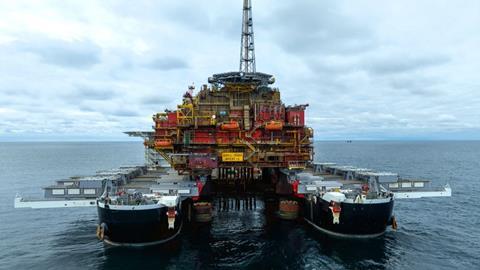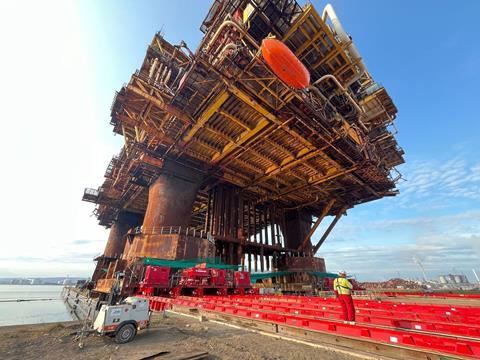Dutch transport engineering specialist Mammoet has performed the decommissioning load-ins of all three gravity-based topsides that were installed at the Brent field in the North Sea. Brent Charlie was the third, last and heaviest of the jobs.
The Brent field was once home to four oil and gas platforms: one jacket-based (Alpha) and three gravity-based (Bravo, Charlie and Delta). Brent Delta ended production in 2011, Alpha and Bravo in 2014, leaving Charlie as the final one in operation.
For Brent Charlie’s decommissioning, skidding the 31,000-tonne topside onto the quayside, whose concrete legs were submerged in seawater for over 40 years, brings complex engineering and safety challenges.

The steps to remove and transport the Charlie topside from the Brent field to the Able Seaton Port near Hartlepool, UK, for decommissioning were largely unchanged from the previous three Brent topsides, providing the peace of mind that comes from a tried-and-tested solution. Allseas used its motion compensated heavy lift vessel Pioneering Spirit to remove the structure at sea in a single lift and transport it to shallow waters, where the topside was transferred onto Iron Lady, Allseas’ purpose-built cargo barge.
Mammoet had already fitted Iron Lady with skidding equipment, which would be needed to offload Brent Charlie at the port. Mammoet also provided mooring winches for Iron Lady within specific guidelines provided by Allseas on lengths and drum load capacities.
Once moored at Able Seaton Port and settled into the seabed, the team could determine the starting height of the skid tracks on the quayside and begin laying them down. The topside was skidded over 12 skid tracks, which needed to be perfectly aligned with the skid tracks installed on the barge.
The skidding operation was performed in two stages. First, the topside was skidded 5 m to the aft of the barge. Then, after 12 hours to allow for further settling, it was skidded the remaining 130 m onto the quay, to its final position. A configuration of 76 skid shoes - divided between the four legs of the platform - and 40 push-pull units were used to skid the topside 15 m per hour. The combined pushing capacity was 3,320 tonnes; the total lift capacity was 51,000 tonnes.

Suspended netting was used to collect any falling debris and marine growth that might come away from the structure. All movements were remotely controlled from a control room to minimise the presence of people underneath the platform, and therefore maximise safety.
Similarly, one of the biggest challenges in the operation was managing Brent Charlie’s four legs, which meant the structure was less stable and more likely to deflect during skidding. “When you look at stability, three legs are always stable; four legs are not,” said Richard Verhoeff, Mammoet sales director. “You try to keep a three-point suspension when performing a load-in, and still need to achieve that even with four legs. That’s where hydraulic grouping comes in very handy”.
Mammoet said that there can also be some level of deflection between the legs, so the force needs to be able to communicate between the different hydraulic groups. This is why there were hydraulic cylinders under each leg, and why the cylinders between both pairs of two legs had to be connected – to ensure the pressure on each remained the same.
















